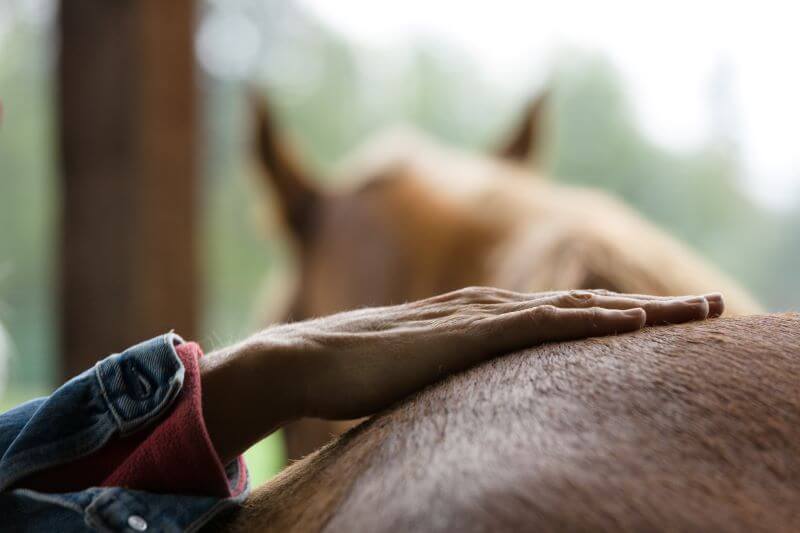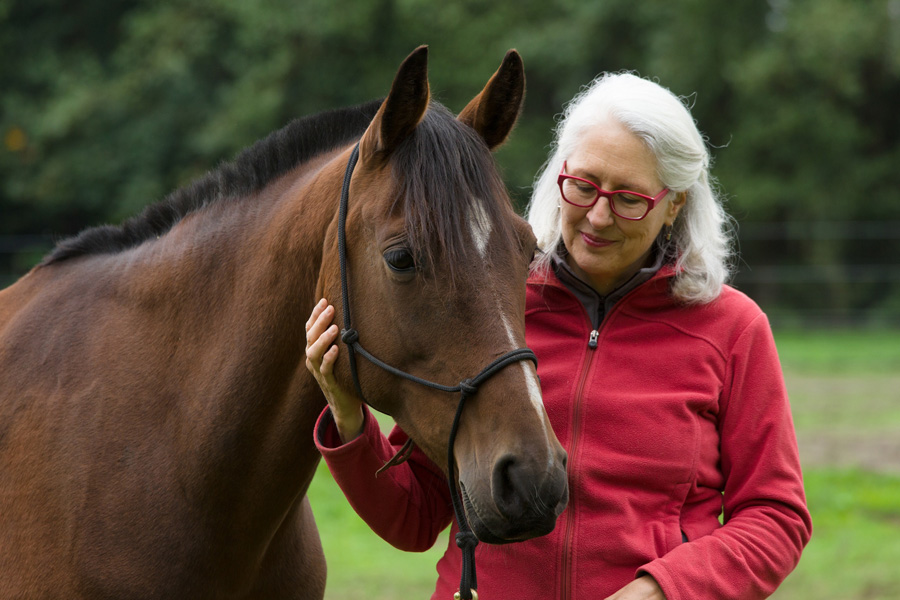Equine Sensitivity Requires Our Thoughtful Handling
by Barbara Breckenfeld

Horses use their sense of touch to navigate their environment, but it also includes how they experience being touched by others. Touch is a major part of our interactions with them: grooming, checking legs, picking feet, haltering, leading, riding, driving, and lunging.
We love horses’ sensitivity, but how we touch them doesn’t always reflect that. Due to horses’ large size and our long-held beliefs about them being dumb, many people hit, slap, and pat. Humans, a puny species by comparison, attempt to control our half-ton partners with hardware on their heads. Understanding how horses are wired might offer other approaches.
Consider Anatomy
Horses’ sense of touch is much more sensitive than humans’—especially their noses. Their whiskers—coarse tactile hairs called vibrissae around the muzzle and eyes—are important sense organs gathering information about the environment, helping sort hay from baling twine, and finding what’s in the bottom of the bucket. They feel the fly on their skin. Every barn has that horse whose prehensile nose can open anything (and does).
Horses’ sensitivity to touch varies widely with thickness of skin, hair coat, breed, age, and density of nerve receptors, most being around the eyes, lips, and nose. Hair follicles and nerves in the dermis layer of skin are receptors for touch, pressure, pain, vibration, temperature.
Sensitive muzzles help foals find the udder. Many predators bite the nose to pull horses down. Using their mouths to lip, lick, chew, bite, warn, defend, and groom, horses paw the ground then touch with their muzzles to evaluate the safety, softness, and depth of ground.
The maxillary branch of the trigeminal nerve is the primary facial nerve, exiting the skull through the infraorbital foramen—where nosebands sit. Its smaller branches sensitize skin on the muzzle, nose, nostrils, and upper lip. Another branch brings sensation to the lower lip and chin, leaving the mandible at the mental foramen— right where flash nosebands go.
How Do Horses Like to be Touched?
Horses prefer to be rubbed and stroked over being tickled or slapped, and they often don’t want rubbing on sensitive areas like the flank, girth, belly, nose, ears, and legs. Several studies observed horses acting calmer during rubbing or stroking compared to patting.
Consider the most sensitive part of your own body and how you like to be touched there. Is anyone welcome to touch you there? Consider offering horses the same level of respect we (should) expect for ourselves and others.
What Can We Do?
Understand how horses are different from people and dogs. Touch them with respect, speak quietly, and patiently observe body language and responses. Exhale, step back and watch (release pressure). Don’t take what the horse does personally. Respect a horse’s muzzle as an exquisitely sensitive sensory center and remember that there’s a blind spot below.
Move slower, touch softer and lighter. If your horse is ticklish, go slowly and firmly. Scratch withers after a ride. Discover another spot your horse naturally enjoys being touched. Stroke their neck or withers to say hello instead of their nose or face. If your horse continually seeks you with his nose, maybe he’s anxious, not rude or affectionate.
Horses move away from light, intermittent pressure because it’s irritating, and they lean into heavy, steady pressure because it’s comforting. A tap or tickle on the ribs is more effective to make a horse move away than steady pressure.
We know horses feel flies on their skin; they also feel our lightest aids during training, and they feel whether we are relaxed or tense. If we use heavy hands or other harsh methods to communicate, they become less responsive.
It’s popular to “desensitize” horses to make a safer ride, creating familiarity through repeated stimulus. Consider that learning (and healing) happens when the horse is in the rest/digest/relax part of its nervous system, not fight/flight/freeze. Some horses find desensitizing extremely stressful. Know your horse and advocate on her behalf.
Keep checking tack fit, and watch body language (the only way the horse can tell you what is going on). Experiment with loosening the tack; is your horse more relaxed?
As with any partnership, we have routines. Being curious and changing our touch from a shout to a whisper could open doors for new levels of connection with your equine partner.

Barbara Breckenfeld of Movement in Balance does equine bodywork/massage and healing in the greater Puget Sound area, as well as offering her popular “Bodywork for Horses” clinics. She is nationally certified by NBCAAM, licensed as a Large Animal Massage Practitioner (LAMP) in Washington State, and an Equine Structural Integration Practitioner certified by the Equine Natural Movement School. Barbara became a horsewoman in 1993 when a handsome dapple-gray won her heart and introduced her to the fundamentals of dressage. Contact Barbara by email [email protected], call 425-260-0784, or visitwww.movementinbalance.com.




